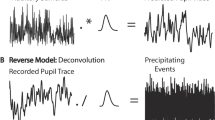Summary
The predictive component of human smooth pursuit was studied by perturbing sinusoidal target motion at unpredictable instants. The disturbances consisted of either a brief period of stabilization of the target on the fovea or a replacement of the sine by a ramp displacement for half a period. To minimize the effects of a possible change of the tracking strategy by the subject the transitions were masked and only the initial part of the response to the disturbance was analyzed. After stabilization on the fovea the eye oscillation continued at the frequency of the preceding target movement for about one half-cycle, whereupon the oscillation was rapidly damped. The mean unidirectional smooth eye acceleration was 70% of the mean unidirectional target acceleration prior to the stabilization. This suggests that during pursuit of a sinusoidal target movement about 75% of the oculomotor response is generated by predictive processes. When the sine was replaced by a ramp, starting at the velocity zero-crossing, the eye accelerated away from the target for ca. 180 ms irrespective of the frequency of prior tracking. In contrast, when the ramp started at the peak velocity of the sinusoidal target motion the eye accelerated away from the target for more than a quarter period. After foveal stabilization during pursuit of a pseudorandom stimulus, the eye continued to oscillate for less than one period at approximately the highest frequency present in the stimulus. The frequency characteristics of human smooth pursuit of predictable as well as unpredictable target motion were correctly simulated by a model, which derived its predictive properties from a lead element, tuned to the current frequency of the target motion.
Similar content being viewed by others
References
Bahill AT, McDonald JD (1983) Model emulates human smooth pursuit system producing zero latency tracking. Biol Cybern 48: 213–222
Becker W, Fuchs AF (1985) Prediction in the oculomotor system: smooth pursuit during transient disappearance of a visual target. Exp Brain Res 57: 562–575
Carl JR, Gellman RS (1986) Adaptive responses in human smooth pursuit. In: Keller EL, Zee DS (eds) Adaptive processes in visual and oculomotor systems. Pergamon Press, Oxford, pp 335–339
Carl JR, Gellman RS (1987) Human smooth pursuit: stimulus dependent responses. J Neurophysiol 57: 1446–1463
Collewijn H, Van der Mark F, Jansen TC (1975) Precise recording of human eye movements. Vision Res 15: 447–450
Collewijn H, Tamminga EP (1984) Human smooth and saccadic eye movements during voluntary pursuit of different target motions on different backgrounds. J Physiol (Lond) 351: 217–250
Dallos PJ, Jones RW (1963) Learning behaviour of the eye fixation control system. IEEE Trans Automat Control AC-8: 218–227
DeWeese Puckett J, Steinman RM (1969) Tracking eye movements with and without saccadic corrections. Vision Res 9: 695–703
Eckmiller R, Mackeben M (1978) Pursuit eye movements and their neural control in the monkey. Pflügers Arch 377: 15–23
Kowler E, Steinman RM (1981) The effect of expectations on slow oculomotor control. III. Guessing unpredictable target displacements. Vision Res 21: 191–203
Lisberger SG, Evinger C, Johanson GW, Fuchs AF (1981) Relationship between eye acceleration and retinal image velocity during foveal smooth pursuit in man and monkey. J Neurophysiol 45: 229–249
Michael JA, Melvill Jones G (1966) Dependence of visual tracking capability upon stimulus predictability. Vision Res 6: 707–716
Mitrani L, Dimitrov G (1978) Pursuit eye movements of a disappearing moving target. Vision Res 18: 537–539
Pola J, Wyatt HJ (1980) Target position and velocity: the stimuli for smooth pursuit eye movements. Vision Res 20: 523–534
Robinson DA (1963) A method of measuring eye movement using a scleral search coil in a magnetic field. IEEE Trans Biomed Electron BME-10: 137–145
Robinson DA (1965) The mechanics of human smooth pursuit eye movements. J Physiol (Lond) 180: 569–591
Robinson DA (1982) A model of cancellation of the vestibular ocular reflex. In: Lennerstrand G, Zee DS, Keller EL (eds) Functional basis of ocular motility disorders. Pergamon Press, Oxford, pp 4–17
Robinson DA, Gordon JL, Gordon SE (1986) A model of the smooth pursuit eye movement system. Biol Cybern 55: 43–57
St Cyr GJ, Fender DH (1969) Non linearities of the human oculomotor system: gain. Vision Res 9: 1235–1246
Stark L, Vossius G, Young LR (1962) Predictive control of the eye tracking movements. IRE Trans Human Fact Electron HFE-3: 52–56
Tychsen L, Lisberger SG (1986) Visual motion processing for the initiation of smooth-pursuit eye movements in humans. J Neurophysiol 56: 953–968
Van den Berg AV, Collewijn H (1987) Voluntary smooth eye movements with foveally stabilized targets. Exp Brain Res 68: 195–204
Von Noorden G, Mackensen G (1962) Pursuit movements of normal and amblyopic eyes. Am J Ophthal 53: 325–336
Whittaker SG, Eaholtz G (1982) Learning patterns of eye motion for foveal pursuit. Invest Ophthalmol Visual Sci 23: 393–397
Wyatt HJ, Pola J (1981) Slow eye movements to eccentric targets. Invest Ophthalmol Visual Sci 21: 477–483
Yasui S, Young LR (1975) Perceived motion as effective stimulus to pursuit eye movement system. Science 190: 906–907
Yasui S, Young LR (1984) On the predictive control of foveal eye tracking and slow phases of optokinetic and vestibular nystagmus. J Physiol (Lond) 347: 17–33
Young LR (1977) Pursuit eye movements — what is being pursued? In: Baker R, Berthoz A (eds) Control of gaze by brain stem neurons. Elsevier, Amsterdam, pp 29–36
Author information
Authors and Affiliations
Rights and permissions
About this article
Cite this article
van den Berg, A.V. Human smooth pursuit during transient perturbations of predictable and unpredictable target movement. Exp Brain Res 72, 95–108 (1988). https://doi.org/10.1007/BF00248504
Received:
Accepted:
Issue Date:
DOI: https://doi.org/10.1007/BF00248504




